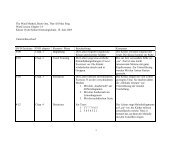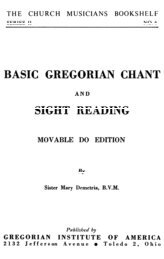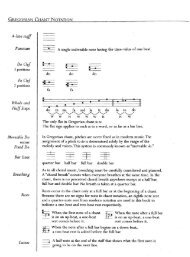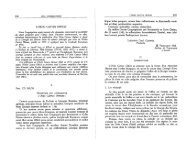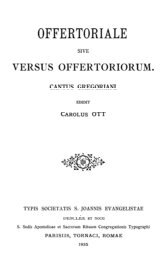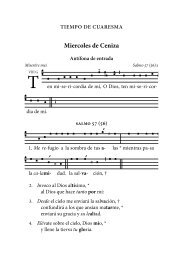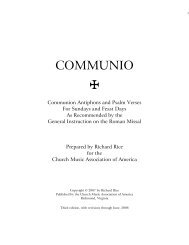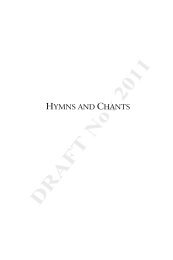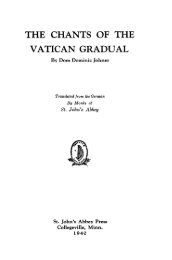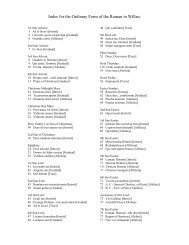Complete English Propers - MusicaSacra
Complete English Propers - MusicaSacra
Complete English Propers - MusicaSacra
Create successful ePaper yourself
Turn your PDF publications into a flip-book with our unique Google optimized e-Paper software.
the spirit and melodic contours of the original chants have been retained. In other modes,<br />
the same type melody is found set to many different Latin texts; these melodies have<br />
been adapted with some frequency to <strong>English</strong> texts in these propers.<br />
The importance of expressing the text, and of making the melodies a vehicle for<br />
this expression, cannot be overemphasized. The accents of the text are the soul of<br />
the melodies; they should be given careful attention as the culmination points of the<br />
dynamic line, even when the accented syllable itself receives but a single note of melody<br />
while the following syllable has many more notes. The horizontal episema (-) below a<br />
note indicates that the notes should be slightly lengthened to punctuate or emphasize<br />
the melodic and textural idea. Bar lines are guides to the proper phrasing of the music.<br />
II. THE PSALM TONES<br />
These are of uniform rhythmic structure, and are interchangeable; however, the tone<br />
should correspond to the modality of the other elements of the musical entity.<br />
Intonations<br />
Intonations are melodic settings for the first two syllables of psalm verses. In general,<br />
intonations are used whenever the psalm verse is immediately preceded by a<br />
chanted melody, antiphon, respond, or alleluia. Intonations may also be used after harmonized<br />
verses or throughout a psalm for greater solemnity. Otherwise, the text may<br />
begin on the recitation note of the psalm setting.<br />
Reciting Tones<br />
The prolonged notes between the intonation and the mediant cadence, and between<br />
the mediant cadence and the final cadence, indicate the reciting tone or tones. The syllables<br />
of the text should move along at a brisk but decorous speed, care being taken to<br />
bring the accents of the text into prominence, and to make the meaning as intelligible<br />
as possible to the entire congregation. Note that the reciting tone for the second half<br />
of each verse is the same as the final note of the mediant cadence.<br />
Cadences<br />
These are measured cadences. The mediant cadence consists of three notes, the accents<br />
falling on the first and third notes. The final cadence consists of five notes, the<br />
accents falling on the first, third, and fifth notes.<br />
The beginning of the mediant cadence is indicated in the text by a single vertical<br />
line: I . The end of the mediant cadence is indicated by a double vertical line: II . A<br />
comma above the text ' indicates a pause, or slight prolonging of the preceding syllable.<br />
The pointing in the antiphon texts beneath chant melodies occasionally indicates<br />
two or three complete repetitions of the psalm tones. In this case, a vertical dotted line<br />
( : ) indicates the end of one verse and the beginning· of the next.<br />
The accents of the text are adapted to the melodic structure of the cadences by<br />
following these rules:<br />
1. Capitalized syllables are sung to two notes of the cadence:<br />
J J JJ J<br />
dis- I tress and SOR - row.<br />
9



